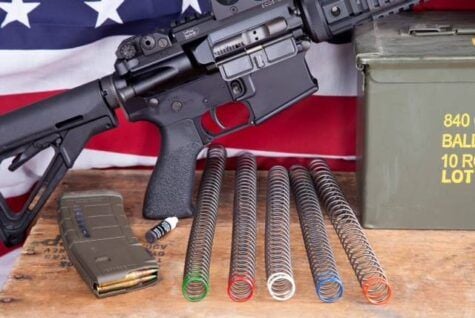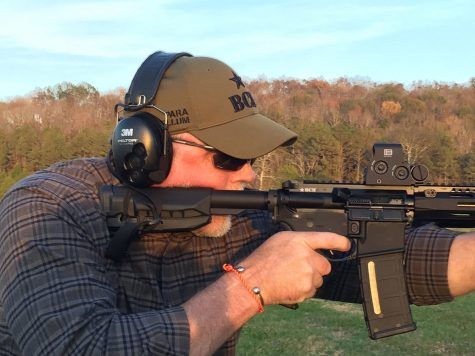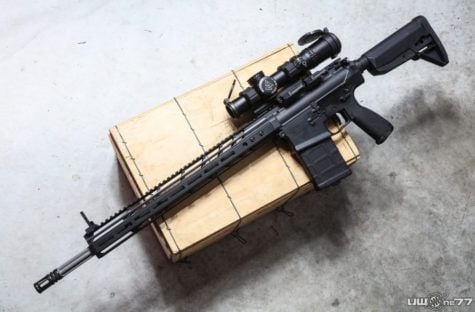
Becoming better at competitive shooting isn’t just about having the latest, greatest gear. It also involves preparation, practice, good organization, and the proper mindset. To learn more about how we can boost our shooting skills, we sat down with John Hatcher of Sun and Shadow and discussed his company, lessons he’s learned about competitive shooting, and any advice he could share.
Q: Let’s start with a bit of background and how Sun and Shadow came about.
John Hatcher, Sun and Shadow – My name is John Hatcher, and by day I am a mechanical engineer, but my side business is Sun and Shadow, and we make accessories and data management tools for scoped rifle supports. I have been shooting all of my life, and for the past 12 years, I have been involved in competitive shooting. That includes pistol, two-gun, precision gas gun, SPR, and DMR matches, and currently, I am seriously involved with the Tactical Games. The Tactical Games Sniper Challenge is a relatively new event. I also enjoy the Quantified Performance matches, which are fun precision gas gun events. I am also involved in a lot of my local 2-gun and IDPA events.

Our goal with Sun and Shadow is really to help grow these kinds of competitive shooting sports. To that end, our Instagram and YouTube are full of tips, tricks, gear, and little details that someone just entering the world of competitive shooting might want to know.
A few things lead to the creation of Sun and Shadow. First of all, one of the key items that we provide for competitive shooting is data management tools, like data cards you can download on our site for free. We make arm bands where you can store your precision rifle data or any other notes for a particular competition that you might be involved with at the time. This all stems from being at a Tactical Games competition a few years ago and one of my friends was acting as an RO for the stage I was shooting.
After the match, I asked him how he thought I did and in the politest way possible, he explained that I looked unorganized. I didn’t have my magazines stored in a proper order, and when I put them back; I did so haphazardly. He said it didn’t really look like I knew what I was doing. I can admit that it hurt a bit to hear that, but at the same time, you can’t be mentally prepared for a competition if you are disorganized. So, I listened to what he said, and I went through my method of doing things – how I store my magazines, how I store my gear, how my data is stored and managed – all so I don’t have to fumble around and look all over the place for things. That is what led me down the organization path. Today, I am convinced that this is one of the most important skills that people need for competitive shooting.

The other side of our business includes items that I felt were necessary for me. I really think that your equipment should fit you. One of our most popular accessories is a riser for SOPMOD stocks. It’s a really great comfortable stock, but at the same time, it’s not really meant in my opinion, for magnified optics or the taller optics that we’re seeing these days, like the 1.7 or 1.9 mounts. You can’t really index your face very well on the SOPMOD, so I made this riser. That helps me to index better behind a magnified optic. We have some other gear that has helped me in various competitions to stay organized; so that’s kind of where our business is going. It’s really geared towards competitive shooting and the little things to make you better.
Q: What is gun number, and why is it important?
John Hatcher, Sun and Shadow – So, as far as data is concerned; specifically around precision guns, you have a lot of little things that add up to where your bullet goes. When people think ballistics, they usually just think, “How far does the bullet drop at this particular range?” But there are other items associated with that. You have both the vertical component of your bullet flight, and you also have a horizontal component which can be affected by a couple of things – primarily, it’s wind that’s pushing your bullet one way or the other.
So with your ballistic profile, you also need to understand the term “gun number.” It’s a very important item that you should understand about your gun. It is especially helpful for understanding how much your bullet will move with a certain wind value at a certain distance. For every 100 yards, your bullet will move .1 MIL horizontally, depending on the wind speed. To give you an example, if you have a 3-mile-per-hour gun, for every 3 miles per hour of 90-degree full-value wind, your bullet is going to move .1 Mil per 100 yards. If you get out to 600 yards, your bullet is going to move .6 for every 3 miles per hour.
When you’re guessing the wind or verifying the wind speed with your Kestral, you can then adjust where your first shot is going to end up in your reticle by using that gun number formula. This might not be the best description, but the key for your readers is to know that “gun number” is very important, and it’s something that they need to take the time to research. Once they understand it, this is the kind of data you can store along with your ballistic table on your gun, in your armband, or wherever you keep your data with you.
Another thing to note is that your gun number can change depending on elevation. I am based in Florida, but I just shot a match in Montana. I went from about 40 feet of elevation to about 4,800 feet of elevation. When I built my profile out there in Montana, I saw that my gun number changed. It’s a 3-mile-per-hour gun in Florida, but it’s a 4-mile-per-hour gun in Montana.
Q: What other data should we be paying attention to for competitive shooting?
John Hatcher, Sun and Shadow – As far as building a ballistic profile for competitive shooting, there are a lot of variables, but velocity is one of them, and you are going to need to know your velocity. A chronograph is something that will help sort that out for you, but you really need to understand what your ammunition is doing velocity-wise. Other things include the BC of your bullet, the twist rate of your rifle, and the environmental conditions of when you gather that velocity data; including the temperature, pressure, and humidity. You need all sorts of inputs in order to get your ballistic profile set correctly.
After you have your ballistic profile and the gun number that we talked about, as far as wind goes, that’s one of those things where you are really only guessing. In competitive shooting, you can tell what the wind is doing at your location by using a Kestral, but you truly can’t tell what the wind is doing between you and your target and at the target because you are not there. Instead, you are looking at things like grass moving, flags moving, or any other environmental factors that might show you what the wind is doing. From there, you just kind of guess at it.

If you’re shooting a match, additional data you’ll want to record for yourself includes the stage setup. That includes where the targets are located, what they look like, what the ranges are, and what the holds for the target will be. Ideally, you’re writing those bits of information down and putting them on your arm or something like that so you can reference them before or during the stage.
One thing I also like to do is write down on my armband my estimates of what the wind is. I will pick an opening hold, writing down the wind holds for each target as my opener, and to the left and the right of those opening holds, I will also write down those in case I guessed the wind incorrectly. I’ll have the values for if I over or underestimate. This makes it very easy to correct your wind holds for every other target on the stage.
Q: Other than data, can you describe what it means to be unorganized in competitive shooting, and what are the things you need to make sure to do to correct those mistakes?
John Hatcher, Sun and Shadow – As far as personal organization in competitive shooting, it is knowing where your gear is on your body all the time. This just doesn’t apply to magazines. It could be your range finder, binoculars, your support bag. You need to know where that stuff is, and you need to be consistent. Pick a spot that works for you, and keep working at it. As far as magazines go in competitive shooting, I have my own internal process where I run my magazines from right to left. They are on my belt, and I pick my right-most magazine first, and as I change mags, I pull the next right-most magazine. Little organizational things like that, always working the same way every time, will help you as far as getting some speed.
There are also mental aspects of organization in competitive shooting, as well. What do you do when you are just preparing for a stage? One of the skills that I have learned pretty recently is visualization. This is one of the keys to winning in competitive shooting. There is a guy in the Tactical Games that I learned this from, and he ‘air-guns’ the stage 10-15 times.
When you watch him do this, you can almost see his thought process. It’s really cool. When he steps up to the line, he’s already won, or he’s near the top, and it’s because he knows exactly what he’s doing when he gets there. He’s organized because he has seen himself shooting that stage a dozen times. He knows what he is going to do, and he doesn’t make mistakes. The visualization process includes exactly where your sights are going to be on the target. So, if it’s a close stage and you are shooting your carbine, you know that you are going to need to aim a little higher because you have height-over-bore.
Another part of that is footwork. Planning exactly where your feet go during a stage. You want to minimize movement in competitive shooting so that you can move exactly from one place to the next without slowing down until you stop at the next position. You’ll cut your time down that way. This is all a part of the visualization process, which is a part of the overarching organizational process.
Q: Can you talk about the speed at which your mind should be going in competitive shooting? I’ve seen you talk before about mentally ‘slowing down.’
John Hatcher, Sun and Shadow – This is a skill that I’ve been working on, and it’s something I learned from the guys at Modern Day Sniper. The way that they describe it is called ‘mindfulness.’ You see everything as data. The bullet, wind, and target are not out to get you. You don’t need to go to war with targets, blasting rounds at them until you get a hit. That’s not a good way to approach the shot. Instead, in competitive shooting, you should be patient. See where the bullet splashes and just take that as data. You don’t need to get mad about it. Be patient and correct your shot based on the data that you see.
Instead of blasting out five rounds to get one hit, maybe you only need to shoot once, and if you don’t get a hit, measure where your splash was and correct from there. That’s two shots instead of five.
I feel a lot slower now. I am taking time in between shots rather than just blasting them out. It’s a gas gun, and there’s the tendency to just want to shoot round after round, but I don’t think that’s a good approach. If you’re patient, you’ll feel slower, but you’ll get more hits. You have to make a conscious decision to do this, but as you work the process, you’ll find the speed will come back, and you’ll end up performing a lot better than your peers who are just blasting out rounds.
Q: Is there anything else that people may not think of that would help improve their performance in competitive shooting that we have not talked about?
John Hatcher, Sun and Shadow – There is an overarching method of going about your skill development in competitive shooting. I didn’t come up with this. I think Neil Batelli taught me this. He has a really neat way of doing things that is a great way of helping new shooters.
First off all, they provide good equipment. Secondly, they provide training opportunities, bringing in reputable instructors to teach their customers how to shoot well. Third, they provide the ability to participate in competitive shooting events. That cycle of equipment, training, and competing is going to get you a lot better results over the long run, I think.
Q: Can you talk briefly about your cheek riser and why it’s something anyone with an LPVO may benefit from, even outside of competitive shooting?
John Hatcher, Sun and Shadow – I use an LPVO when I shoot both Quantified Performance and Tactical Games. I use a Vortex Razor 1-10, and as far as getting behind the gun on a magnified optic, the eye box is smaller than what you have on something like a red dot where you can see that dot from pretty much anywhere. Now you’re trying to get your eye into the box, as there is only a certain place that your eye can be behind that gun to see the image in front of you.

With magnified optics and taller mounts, something weird happens when you get behind them. You’re putting the meat of your cheek on the stock, and that does not provide you with a real, definitive index point. Any time you mount the gun, you are trying to search for the eye box. It does not take long. It could be a quarter of a second, but that’s a quarter of a second where you could be shooting. When time is of the essence, and those quarter seconds add up during a competitive shooting event, especially when you have multiple targets coming in and out of the scope over and over again.
The point of my cheek riser is to help you index on your cheekbone rather than on the meat of your cheek. The cheekbone is not going to move around. It is a much smaller and sharper point for you to put your face on. This helps you index in the right spot every time you mount the gun rather than searching through the eyepiece trying to find it. Its just something that can help you fit the gun better.
Q: At what height do you need a riser like this. 1.70” or would you use one at something like 1.54”
John Hatcher, Sun and Shadow – I actually use one for 1.54. Except for a few of my night vision guns, that’s pretty much where all of my optics sit. A lot of people are transitioning over to taller mounts because they feel like it helps their neck strain and their face is more upright while shooting. That said, if you’ve ever been behind a taller mount, you might notice that they are not great for prone shooting. Prone shooting comes up pretty often with long-range stuff. As such, the cheek riser is something that really benefits me, but at the end of the day, it’s just one part of a bigger puzzle that involves being prepared mentally, and physically, and making sure the gear you have can help you perform better.
###





